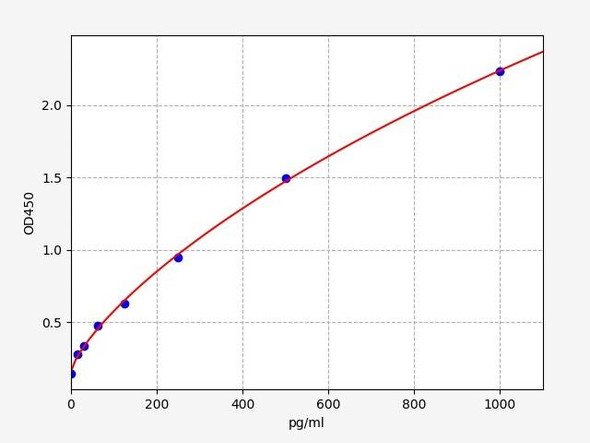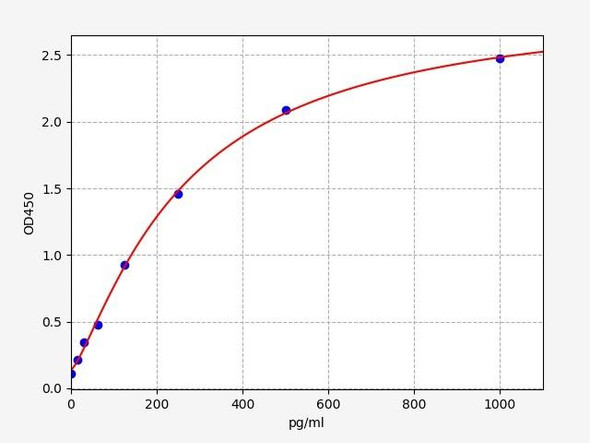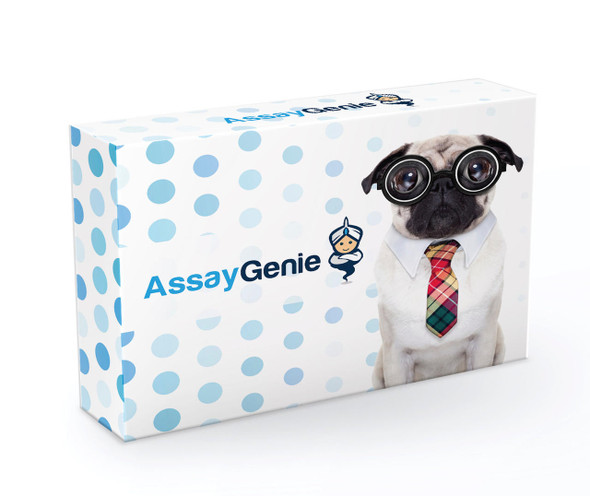Mouse Cardiovascular ELISA Kits
Mouse bFGF/FGF2 (Basic Fibroblast Growth Factor) ELISA Kit (MOES00754)
- SKU:
- MOES00754
- Product Type:
- ELISA Kit
- Size:
- 96 Assays
- Uniprot:
- P15655
- Sensitivity:
- 9.38pg/mL
- Range:
- 15.63-1000pg/mL
- ELISA Type:
- Sandwich
- Synonyms:
- FGF-2, B-FGF, BFGF, FGFB, HBGF-2, prostatropin, heparin-binding growth factor 2
- Reactivity:
- Mouse
- Sample Type:
- Serum, plasma and other biological fluids
- Research Area:
- Cardiovascular
Description
| Assay type: | Sandwich |
| Format: | 96T |
| Assay time: | 4.5h |
| Reactivity: | Mouse |
| Detection Method: | Colormetric |
| Detection Range: | 15.63-1000 pg/mL |
| Sensitivity: | 9.38 pg/mL |
| Sample Volume Required Per Well: | 100µL |
| Sample Type: | Serum, plasma and other biological fluids |
| Specificity: | This kit recognizes Mouse bFGF/FGF2 in samples. No significant cross-reactivity or interference between Mouse bFGF/FGF2 and analogues was observed. |
This ELISA kit uses Sandwich-ELISA as the method. The micro ELISA plate provided in this kit has been pre-coated with an antibody specific to Mouse bFGF/FGF2. Standards or samples are added to the appropriate micro ELISA plate wells and combined with the specific antibody. Then a biotinylated detection antibody specific for Mouse bFGF/FGF2 and Avidin-Horseradish Peroxidase (HRP) conjugate are added to each micro plate well successively and incubated. Free components are washed away. The substrate solution is added to each well. Only those wells that contain Mouse bFGF/FGF2, biotinylated detection antibody and Avidin-HRP conjugate will appear blue in color. The enzyme-substrate reaction is terminated by adding Stop Solution and the color turns yellow. The optical density (OD) is measured spectrophotometrically at a wavelength of 450 nm ± 2 nm. The OD value is proportional to the concentration of Mouse bFGF/FGF2. The concentration of Mouse bFGF/FGF2 in samples can be calculated by comparing the OD of the samples to the standard curve.
| UniProt Protein Function: | FGF2: Plays an important role in the regulation of cell survival, cell division, angiogenesis, cell differentiation and cell migration. Functions as potent mitogen in vitro. Monomer. Homodimer. Interacts with FGFR1, FGFR2, FGFR3 and FGFR4. Affinity between fibroblast growth factors (FGFs) and their receptors is increased by heparan sulfate glycosaminoglycans that function as coreceptors. Interacts with CSPG4, FGFBP1 and TEC. Found in a complex with FGFBP1, FGF1 and FGF2. Expressed in granulosa and cumulus cells. Expressed in hepatocellular carcinoma cells, but not in non- cancerous liver tissue. Belongs to the heparin-binding growth factors family. 4 isoforms of the human protein are produced by alternative initiation. |
| UniProt Protein Details: | Protein type:Activator; Motility/polarity/chemotaxis Cellular Component: extracellular space; cytoplasm; extracellular region; nucleus; cytosol Molecular Function:heparin binding; protein binding; ligand-dependent nuclear receptor transcription coactivator activity; growth factor activity; cytokine activity; chemoattractant activity; receptor binding; fibroblast growth factor receptor binding Biological Process: wound healing; activation of MAPKK activity; regulation of cell cycle; multicellular organismal development; positive regulation of transcription, DNA-dependent; positive regulation of smooth muscle cell proliferation; adrenocorticotropin hormone secreting cell differentiation; cardiac muscle cell proliferation; thyroid stimulating hormone secreting cell differentiation; hyaluronan catabolic process; growth factor dependent regulation of satellite cell proliferation; embryonic development ending in birth or egg hatching; positive regulation of MAP kinase activity; negative regulation of cell proliferation; substantia nigra development; glial cell differentiation; positive chemotaxis; induction of an organ; positive regulation of cell proliferation; regulation of retinal cell programmed cell death; response to axon injury; angiogenesis; cell differentiation; positive regulation of granule cell precursor proliferation; positive regulation of cardiac muscle cell proliferation; fibroblast growth factor receptor signaling pathway; positive regulation of cell fate specification; positive regulation of blood vessel endothelial cell migration; positive regulation of phosphoinositide 3-kinase activity; negative regulation of blood vessel endothelial cell migration; positive regulation of protein kinase B signaling cascade; positive regulation of osteoblast differentiation; positive regulation of angiogenesis; stem cell development; cell migration during sprouting angiogenesis; ureteric bud branching; positive regulation of cell division; release of sequestered calcium ion into cytosol; phosphatidylinositol biosynthetic process; positive regulation of endothelial cell proliferation; positive regulation of transcription from RNA polymerase II promoter; positive regulation of protein amino acid phosphorylation; positive regulation of cell differentiation; inositol phosphate biosynthetic process; positive regulation of epithelial cell proliferation; lung development |
| UniProt Code: | P15655 |
| NCBI GenInfo Identifier: | 122743 |
| NCBI Gene ID: | 14173 |
| NCBI Accession: | P15655. 1 |
| UniProt Related Accession: | P15655 |
| Molecular Weight: | 17,153 Da |
| NCBI Full Name: | Fibroblast growth factor 2 |
| NCBI Synonym Full Names: | fibroblast growth factor 2 |
| NCBI Official Symbol: | Fgf2 |
| NCBI Official Synonym Symbols: | Fgfb; bFGF; Fgf-2 |
| NCBI Protein Information: | fibroblast growth factor 2; HBGF-2; basic fibroblast growth factor; heparin-binding growth factor 2 |
| UniProt Protein Name: | Fibroblast growth factor 2 |
| UniProt Synonym Protein Names: | Basic fibroblast growth factor; bFGF; Heparin-binding growth factor 2; HBGF-2 |
| Protein Family: | Fibroblast growth factor |
| UniProt Gene Name: | Fgf2 |
| UniProt Entry Name: | FGF2_MOUSE |
As the OD values of the standard curve may vary according to the conditions of the actual assay performance (e. g. operator, pipetting technique, washing technique or temperature effects), the operator should establish a standard curve for each test. Typical standard curve and data is provided below for reference only.
| Concentration (pg/mL) | O.D | Average | Corrected |
| 1000 | 2.413 2.461 | 2.437 | 2.359 |
| 500 | 1.72 1.778 | 1.749 | 1.671 |
| 250 | 0.937 0.905 | 0.921 | 0.843 |
| 125 | 0.509 0.515 | 0.512 | 0.434 |
| 62.5 | 0.295 0.291 | 0.293 | 0.215 |
| 31.25 | 0.192 0.17 | 0.181 | 0.103 |
| 15.63 | 0.126 0.136 | 0.131 | 0.053 |
| 0 | 0.076 0.08 | 0.078 | -- |
Precision
Intra-assay Precision (Precision within an assay): 3 samples with low, mid range and high level Mouse bFGF/FGF2 were tested 20 times on one plate, respectively.
Inter-assay Precision (Precision between assays): 3 samples with low, mid range and high level Mouse bFGF/FGF2 were tested on 3 different plates, 20 replicates in each plate.
| Intra-assay Precision | Inter-assay Precision | |||||
| Sample | 1 | 2 | 3 | 1 | 2 | 3 |
| n | 20 | 20 | 20 | 20 | 20 | 20 |
| Mean (pg/mL) | 53.70 | 84.40 | 465.10 | 50.80 | 84.20 | 471.70 |
| Standard deviation | 3.50 | 4.10 | 21.90 | 3.50 | 4.00 | 15.10 |
| C V (%) | 6.52 | 4.86 | 4.71 | 6.89 | 4.75 | 3.20 |
Recovery
The recovery of Mouse bFGF/FGF2 spiked at three different levels in samples throughout the range of the assay was evaluated in various matrices.
| Sample Type | Range (%) | Average Recovery (%) |
| Serum (n=5) | 91-105 | 98 |
| EDTA plasma (n=5) | 94-105 | 99 |
| Cell culture media (n=5) | 83-96 | 90 |
Linearity
Samples were spiked with high concentrations of Mouse bFGF/FGF2 and diluted with Reference Standard & Sample Diluent to produce samples with values within the range of the assay.
| Serum (n=5) | EDTA plasma (n=5) | Cell culture media (n=5) | ||
| 1:2 | Range (%) | 93-106 | 85-98 | 96-110 |
| Average (%) | 99 | 91 | 103 | |
| 1:4 | Range (%) | 97-109 | 87-101 | 95-105 |
| Average (%) | 103 | 92 | 100 | |
| 1:8 | Range (%) | 95-112 | 85-96 | 94-107 |
| Average (%) | 103 | 91 | 101 | |
| 1:16 | Range (%) | 101-114 | 81-95 | 95-109 |
| Average (%) | 108 | 87 | 101 |
An unopened kit can be stored at 4°C for 1 month. If the kit is not used within 1 month, store the items separately according to the following conditions once the kit is received.
| Item | Specifications | Storage |
| Micro ELISA Plate(Dismountable) | 8 wells ×12 strips | -20°C, 6 months |
| Reference Standard | 2 vials | |
| Concentrated Biotinylated Detection Ab (100×) | 1 vial, 120 µL | |
| Concentrated HRP Conjugate (100×) | 1 vial, 120 µL | -20°C(shading light), 6 months |
| Reference Standard & Sample Diluent | 1 vial, 20 mL | 4°C, 6 months |
| Biotinylated Detection Ab Diluent | 1 vial, 14 mL | |
| HRP Conjugate Diluent | 1 vial, 14 mL | |
| Concentrated Wash Buffer (25×) | 1 vial, 30 mL | |
| Substrate Reagent | 1 vial, 10 mL | 4°C(shading light) |
| Stop Solution | 1 vial, 10 mL | 4°C |
| Plate Sealer | 5 pieces | |
| Product Description | 1 copy | |
| Certificate of Analysis | 1 copy |
- Set standard, test sample and control (zero) wells on the pre-coated plate and record theirpositions. It is recommended to measure each standard and sample in duplicate. Note: addall solutions to the bottom of the plate wells while avoiding contact with the well walls. Ensuresolutions do not foam when adding to the wells.
- Aliquot 100µl of standard solutions into the standard wells.
- Add 100µl of Sample / Standard dilution buffer into the control (zero) well.
- Add 100µl of properly diluted sample (serum, plasma, tissue homogenates and otherbiological fluids) into test sample wells.
- Cover the plate with the sealer provided in the kit and incubate for 90 min at 37°C.
- Aspirate the liquid from each well, do not wash. Immediately add 100µL of BiotinylatedDetection Ab working solution to each well. Cover the plate with a plate seal and gently mix. Incubate for 1 hour at 37°C.
- Aspirate or decant the solution from the plate and add 350µL of wash buffer to each welland incubate for 1-2 minutes at room temperature. Aspirate the solution from each well andclap the plate on absorbent filter paper to dry. Repeat this process 3 times. Note: a microplatewasher can be used in this step and other wash steps.
- Add 100µL of HRP Conjugate working solution to each well. Cover with a plate seal andincubate for 30 min at 37°C.
- Aspirate or decant the solution from each well. Repeat the wash process for five times asconducted in step 7.
- Add 90µL of Substrate Reagent to each well. Cover with a new plate seal and incubate forapproximately 15 min at 37°C. Protect the plate from light. Note: the reaction time can beshortened or extended according to the actual color change, but not by more than 30min.
- Add 50 µL of Stop Solution to each well. Note: Adding the stop solution should be done inthe same order as the substrate solution.
- Determine the optical density (OD value) of each well immediately with a microplate readerset at 450 nm.






